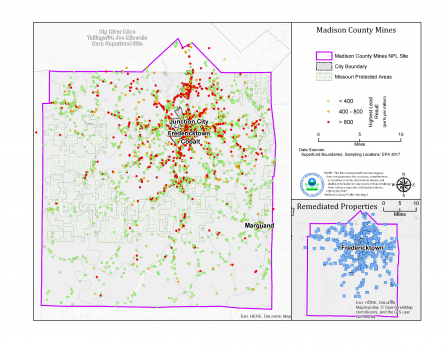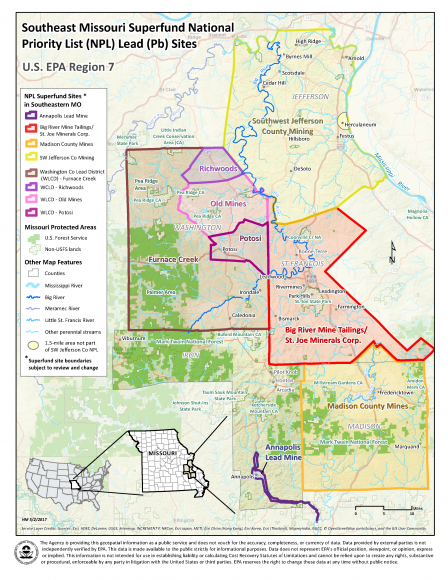Madison County Mines National Priorities List (NPL) Superfund Site, Madison County, Missouri - Fact Sheet, January 2020
Lead Testing and Cleanup Opportunity
OVERVIEW OF CLEANUP AND FREE LEAD TESTING
The U.S. Environmental Protection Agency (EPA) Region 7 is remediating (cleaning up) lead-contaminated soil in residential properties within the Madison County Mines (MCM) National Priorities List (NPL) Superfund Site. The site covers Madison County in its entirety and the Mine La Motte tract in southern St. Francois County.
EPA is asking residential property owners in Madison County for access to conduct free lead contamination testing by EPA’s field support contractor Tetra Tech. If your property has been tested and is eligible for remediation [at 400 parts per million (ppm) lead or higher], EPA’s contractor, Environmental Restoration, will perform the cleanup for free. EPA is approaching the end of the MCM residential cleanup, so do not miss out on the opportunity to have your property remediated.
If your residential property has not been tested for lead contamination, talk with EPA or the Madison County Health Department about testing your yard or private well (see "How Will EPA Clean Up My Property" below); sampling and cleanup is performed at no cost to property owners. Residential properties are defined as and include residential yards, public use areas, and child high-use areas (such as child care facilities, public parks, playgrounds, and other public recreational facilities). This cleanup may also include associated unimproved roadways/alleys, rights-of-way, and stormwater drainages.
Lead is a toxic metal that is harmful if inhaled or swallowed; it is the main contaminant of concern at the site. Lead is classified by EPA as a probable human carcinogen and is a cumulative toxicant.
Lead exposure can pose serious health risks, particularly for children 7 years old and younger, pregnant women, and nursing mothers. Pregnant women and nursing mothers should avoid exposure to lead to protect their children. Lead exposure can cause a range of adverse health effects, including behavioral disorders, learning disabilities and seizures, putting young children at the greatest risk because their brains and nervous systems are still developing. Children 7 years old and younger are most at risk from developing health effects from exposure to lead. It is important that children in this age range be tested annually because lead-poisoned children do not always look or act sick. The only way to know if your child has elevated blood lead levels is to have his or her blood tested. Your doctor can do a simple blood test to check your child, or you, for lead exposure. Talk to your child’s doctor, general physician, or your local health agency about a simple blood test for your child (see more information below).
 Figure 1: Madison County Mines NPL Site Map - click to enlarge
Figure 1: Madison County Mines NPL Site Map - click to enlarge
CURRENT SITE STATUS
At the MCM site, to protect human health and the environment from the dangers of lead, EPA has sampled (tested) over 5,000 residential properties for lead contamination and over 2,080 residential properties have been cleaned up since work began. (See Figure 1 at right.) Many more properties are eligible for remediation. In conjunction with the soil sampling, private drinking water wells have also been tested for elevated lead levels where both the county and EPA routinely test private domestic wells for metals contamination.
EPA has also remediated over 750,000 cubic yards of contaminated soil and approximately 87 acres of mine waste since 2000. Around 10 to 15 million cubic yards of mine waste were generated in Madison County, and seven of the 13 mine waste piles within the site have been remediated.
SITE BACKGROUND
The MCM site is part of the Old Lead Belt in southeastern Missouri and was one of the world’s largest lead mining districts. (See Figure 2 at right.) Mining began in the early 1700s and produced more than 9 million tons of lead. Extensive lead mining, milling, and smelting activities resulted in contaminated soil, sediment, surface water, and groundwater with elevated levels of heavy metals, primarily lead, prompting the need for state and EPA involvement.
 Figure 2: Southeast Missouri Superfund NPL Lead Sites - click to enlarge
Figure 2: Southeast Missouri Superfund NPL Lead Sites - click to enlarge
Contaminated materials have been transported and used as soil and fill at residences, as soil amendment, and as road base and used in yards, driveways, parking areas, and playgrounds throughout the MCM site. The site was listed to the National Priority List in 2003.
HOW WILL EPA CLEAN UP MY PROPERTY?
If your residential property qualifies for cleanup, EPA will include an access agreement with the sampling results letter. By signing and returning the access agreement, owners are taking the first step in the process to allow the EPA contractor to clean up the affected areas of the yard. This work is being conducted at no cost to the property owner. This process is summarized in five simple steps:
Step 1: The EPA contractor will schedule a time to meet with the homeowner, review the affected areas of the yard, answer any questions, and address any concerns.
Step 2: The EPA contractor will ask the owner to sign the checklist and give them final permission to start the work. Once utilities are located, the cleanup can begin within a few weeks, weather permitting. The contractor’s checklist of items to discuss will include the location of private utilities installed by the homeowner at the property and determining the best way to move equipment in and out. It is the responsibility of the contractor to have utilities marked and work around them as necessary. If the contractor damages utilities or any personal property through its own negligence, the contractor is responsible for repairs at no cost to the owner.
Step 3: The cleanup generally includes excavating up to one foot of soil or gravel from areas that qualify for cleanup. If the base of the excavation is still above the EPA action level at one foot of depth, it will be excavated to two feet. If lead concentrations remain high at the base of the excavation, a highly visible barrier will be placed prior to backfilling with clean materials. The barrier is placed to warn anyone who disturbs soil in its location that contamination remains at depth and special handling of the soil beneath the barrier is required to prevent exposure.
Step 4: The EPA contractor will then fill the excavation with clean soil, return the grade to the original contours, and restore the lawn. Note: The contractor is only permitted to restore the property to its original condition without making improvements, and is required to repair or replace any items damaged through its own negligence during the cleanup process.
Step 5: Once the restoration work is complete, EPA and its contractor will request a final meeting with the owner to review the work and sign a final checklist to confirm satisfactory completion.
MADISON COUNTY HEALTH DEPARTMENT offers free lead testing for children and free residential yard testing. Contact Becky Hunt (Director), Teresa Rehkop (Lead Nurse), or Becky McFarland (Free Soil Testing and Voluntary Institutional Controls Program) at 806 W. College, Fredericktown, MO 63645; phone: 573-783-2747; website: www.madisoncountymohealth.com.
EPA CONTACT INFORMATION
Questions or requests for site information can be submitted to:
Lenexa, KS 66219
Lenexa, KS 66219
Lenexa, KS 66219
ATSDR/CDC CONTACT INFORMATION
Questions can be submitted to:
LCDR Cory Kokko
U.S. Public Health Service
Phone: 913-217-5981
Email: ckokko@cdc.gov
FOR ADDITIONAL LEAD AND SITE INFORMATION
The Administrative Record file for this site is available on EPA's website (under Site Documents and Data).
- CDC’s Lead page
- CDC’s ATSDR Lead ToxFAQs™
- EPA's Lead pages: www.epa.gov/lead and www.epa.gov/lead/learn-about-lead
- EPA’s Protect Your Family from Lead in Your Home
- EPA posts Fact Sheets for Missouri cleanup sites online
